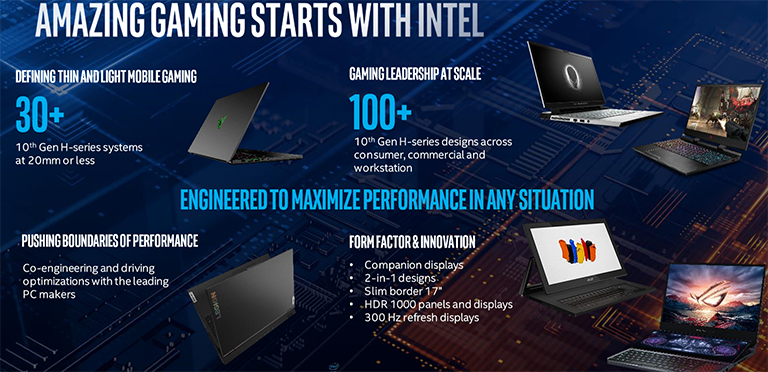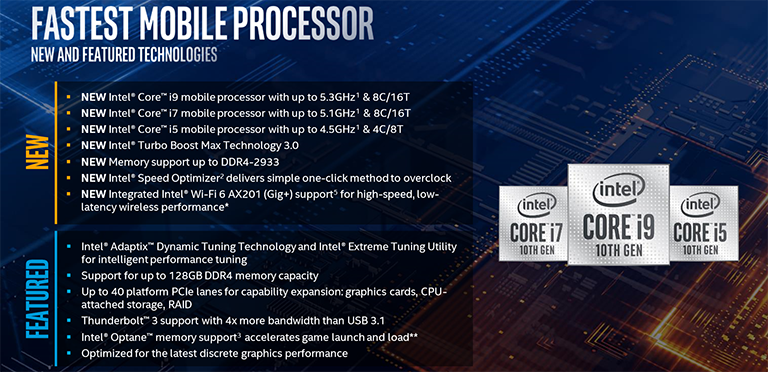Things are brewing nicely in the mobile high-performance CPU space this summer. We know this because AMD has brought its latest Zen 2 architecture to bear on Ryzen Mobile 4000-series chips designed around common 15W and 45W TDPs. Rival Intel today announces its riposte with a number of Core 10th Gen H-series processors based on the Comet Lake architecture. In direct competition to AMD's premier offerings, these 45W chips, complete with integrated UHD Graphics, are also designed to go into high-performance gaming and creator laptops featuring attached graphics from either Nvidia or AMD.
Intel has a firm grip on the high-performance laptop market with its incumbent Core 9th Gen chips based on the Coffee Lake blueprint. It's relatively easy to convince OEM partners to build out laptops on newer CPU technology, so fully expect the likes of Dell, HP, Acer, Razer, Gigabyte, MSI, Asus, Lenovo, et al, to update current models with the latest processors.
It's no surprise that Intel reckons that over 100 gaming-focussed machines are in the works, with over 30 conforming to a thin-and-light form factor. The key question is what makes 10th Gen Comet Lake technology better than 9th Gen Coffee Lake. Let's examine.
First off, Comet Lake is not a brand-new technology. It's accurately described as 4th Generation Skylake, and remains stuck on a refined 14nm process. Intel first debuted it in mobile 15W (U-series) form last August and now, belatedly, moves it over to the high-performance mobile space.
Being stuck on the same ageing process brings with it other considerations. Unlike AMD, whose latest H-series silicon uses 7nm processing and double the core-and-thread count of the previous generation, Intel keeps to 4/8, 6/12, and 8/16 topologies for the Core i5, Core i7, and Core i9, respectively.
The Benefits of 10th Gen H-series
The main reason for Comet Lake resides with frequency increases across the entire range. Intel rightfully identifies that having higher clocks plays better with games run at lower resolutions, and backs up the MHz upticks with memory support at DDR4-2,933 instead of 2,666MHz. We reckon it could have gone further and mandated DDR4-3,200 for all chips. Being a new platform with a revised pin layout, the CPU is paired with the H470 chipset via the standard 8GT/s link found on 9th Gen.
There's also a numerical bump in WiFi technology, though perusing the specifications shows no meaningful benefit for most OEMs, while the Intel Optimizer ought to make it easier for users to overclock, should the OEM allow it.
Speeds and Feeds
Focussing on the parts themselves, a couple of things become apparent. Intel increases the maximum single-core turbo frequency across all chips - it's good to see at least 5GHz on four chips. Comparing like for like from the previous generation, there's between 300MHz and 500MHz more turbo, which is a solid testament to the manufacturing progress Intel continues to make on 14nm. That said, Intel would not divulge all-core speeds that are more meaningful for creators whose applications span cores and threads.
Introduced on the last generation, more chips benefit from Thermal Velocity Boost this time around, where the processor can temporarily hit higher-than-turbo frequencies if there's sufficient temperature headroom and power budget available. On a recent call, Intel reckoned the chips ought to run with TVB for bursty workloads if below 65°C. That said, there's no hard-and-fast rule, and it will be up to OEMs to design excellent cooling that can take advantage of it.
Only the top-spec Core i9 is unlocked, keeping consistency with the previous generation. The Core i7-10850 is partially unlocked, like the previous-gen Core i7-9850H, and what this means in practise is that it can jump up to four higher turbo bins if the OEM so chooses.
Last but not least, the Core i9 chip has a cTDP that can, if sufficient cooling exists, be pumped up to 65W for even faster performance.
The Wrap
In a wholly anticipated move, Intel moves its performance H-series mobile Core chips over to the Comet Lake 14nm process whose main benefit over incumbent Coffee Lake is higher single-core frequency that ought to improve general system performance as well as providing more oomph for gaming.
The 10th Gen Core H-series chips are not the game-changers as the Ice Lake-infused U-series parts - these a bit faster than last-gen, but still reliant on old manufacturing technology - so it will be interesting to see how identical laptops featuring Intel and AMD's latest H-series play out over the summer months. Interesting times ahead.

















